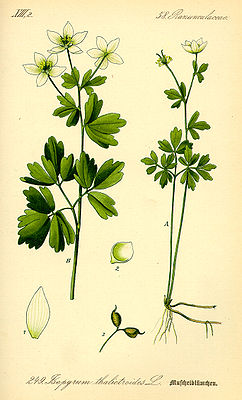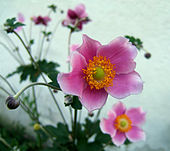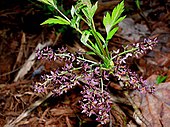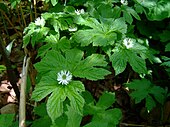Buttercups
| Buttercups | ||||||||||||
|---|---|---|---|---|---|---|---|---|---|---|---|---|

Meadow rue mussels ( Isopyrum thalictroides ), illustration |
||||||||||||
| Systematics | ||||||||||||
|
||||||||||||
| Scientific name | ||||||||||||
| Ranunculaceae | ||||||||||||
| Yuss. |
The buttercup plants (Ranunculaceae) are a family in the order of the buttercups (Ranunculales) within the flowering plants (Magnoliopsida). This family comprises about 62 genera with about 2525 species and is represented worldwide, mainly in the temperate zones of the northern hemisphere.
All buttercups contain protoanemonin and are therefore poisonous to animals.
description
The representatives of the buttercup family show very original characteristics within the bedecktsamer . Typical features for this are the high and indeterminate number of flower organs, their frequent screwy position, the choricarpic ovary and transitions between the organs. The function of the calyx as protection in the bud stage can be taken over by bracts just below the perigone (e.g. Hepatica ). On the other hand, this function can also be taken over by petaloid nectar leaves, which first transformed from stamens into nectar leaves and then became corolla-like, e.g. B. in the genus Ranunculus .
Habit and leaves
Most of them are herbaceous plants , very often they are perennial plants , more rarely annuals; there is also woody plants: half bushes , shrubs ( Xanthorhiza ) and vines ( Clematis ). In some species, rhizomes ( e.g. Coptis ) are formed as persistence organs. The leaves are usually arranged alternately. The exception is e.g. B. the genus Clematis , in which the leaf position is opposite. The leaves are often divided or articulated. There are usually no stipules present.
Occasionally only one cotyledon, but mostly two cotyledons (is cotyledons ) exist, which are often grown together.
Inflorescences and flowers

The flowers are, often on an inflorescence stem, individually or in zymose , racemose or paniculate inflorescences together.
The flowers are mostly hermaphroditic. While some genera ( e.g. monkshood ) have zygomorphic flowers, most buttercups have simple radial symmetry flowers, although carpels and stamens are often screwed. In contrast to the majority of the other taxa of the Bedecktsamer, the inflorescence consists mostly of a circle of bloom. The exception is e.g. B. the genus Adonis , whose flower envelope is divided into calyx and crown. The number of bracts varies within the family from four bracts, for example in clematis, to many bracts, for example in celandine . The five to fifty free bracts are in one or two circles.
Many taxa have nectar leaves, which are nectar-secreting flower organs, which are derived from the anthers (stamens) and are not a real petal. These honey leaves have a nectar pocket at the bottom.
The stamens and carpels are usually present in large numbers. Both are often screwed up. All of the 15 to 100 stamens can be fertile or the outer ones are staminodes . The 3 to 100 carpels are mostly free (= chorikarp ) and are only fused in a few taxa.
The flower formula is:
The pollination is usually by insects ( Entomophilie ), rarely ( Thalictrum ) by the wind ( anemophily ).
fruit
Most of the fruits of the buttercup family also show relatively original characteristics, especially the follicles , which are often pelvic fruits. There are also taxa with nuts . A few taxa produce capsule fruits or berries .
ingredients
Important ingredients are Esteralkaloide, for example, the most toxic substance Aconitin at Eisenhut ( Aconitum ). Other alkaloids such as protoanemonine , diterpene alkaloids and isoquinoline alkaloids also occur frequently.













Systematics and distribution
The Ranunculaceae family was established in 1789 by Antoine Laurent de Jussieu . Synonyms for Ranunculaceae Juss. are: Aconitaceae Bercht. & J. Presl , Actaeaceae Bercht. & J.Presl , Anemonaceae Vest , Aquilegiaceae Lilja , Cimicifugaceae Bromhead , Coptaceae Á.Löve & D.Löve nom. inval., Glaucidiaceae Tamura , Helleboraceae Vest , Hydrastidaceae Martinov , Nigellaceae J.Agardh , Thalictraceae Raf.
The buttercups are distributed worldwide with centers of abundance in the temperate , cold-temperate and boreal areas of the northern and southern hemispheres .
The Ranunculaceae family is divided into five subfamilies and eleven or twelve tribes . Only two subfamilies also contain taxa in Central Europe.
The Ranunculaceae family contains around 56 to 62 genera with around 2525 species (all genera and a selection of some species):
- Subfamily Ranunculoideae Arnott : It contains ten tribe with about 38 to 46 genera and about 2025 species:
- Tribus Actaeeae Spach (Syn .: Cimifugae Torr. & A.Gray ): It contains four genera:
- Christopher's herbs ( Actaea L. ): It contains including Cimicifuga Wernisch. about 20 species in the northern hemisphere .
-
Anemonopsis sieve. & Zucc. : It contains only one type:
- Sham anemone ( Anemonopsis macrophylla Sieb. & Zucc. ): It occurs only in Japan.
- Beesia Balf. f. & WWSm. : The two or three species are found in Myanmar and western China.
- Winterlings ( Eranthis Salisb. ): The seven or so species are common in Eurasia .
- Tribe Adonideae Kunth : with four genera:
- Adonisröschen ( Adonis L. ): The approximately 30 species are common in Eurasia. Four species are native to Central Europe.
-
Megaleranthis Ohwi : It contains only one species:
- Megaleranthis saniculifolia Ohwi : It is only found in South Korea .
- Globeflowers ( Trollius L. ): The 30 or so species are common in the northern hemisphere.
- Tribe Anemoneae DC. : It contains seven to nine genera:
- Anemone ( Anemone L. ): It contains 150 to 190 species (depending on whether Hepatica and Pulsatilla are incorporated or not)
-
Archiclematis (Tamura) Tamura (sometimes in Clematis L. ): It contains only one species:
- Archiclematis alternata (Kitam. & Tamura) Tamura (Syn .: Clematis alternata Kitam. & Tamura ): It is native to China.
- Barneoudia Gay : The four species only thrive in the alpine altitude range in Chile and Argentina.
- Clematis ( Clematis L. ): It contains about 325 species almost worldwide.
- Liverwort ( Hepatica Mill. ): It is often included in the genus Anemone . With about seven species in the northern temperate zones.
- Knowltonia Salisb. : The position of these two to ten species is controversial, they are often placed in the genus Anemone . They occur in eastern and southern Africa.
-
Metanemone W.T.Wang : It contains only one species:
- Metanemone ranunculoides W.T.Wang : It is endemic to mountain slopes at altitudes of around 3500 meters in northwestern Yunnan .
- Naravelia Adans. : The nine or so species are distributed in southern Asia and Southeast Asia.
-
Oreithales Schltdl. : It contains only one type:
- Oreithales integrifolia (DC.) Schltdl. : It only thrives in the higher puna in Bolivia and Peru.
- Pasque Flower ( Pulsatilla Mill. ): It is often included in the genus Anemone . The 30 or so species are widespread in Eurasia and North America. Several species are native to Central Europe.
- Tribe Asteropyreae WTWang & CYChang : It contains only one genus:
- Asteropyrum J.R.Drumm. & Hutch. : It contains only two types in China.
- Tribus Caltheae Bercht. & J.Presl : It contains only two or three genres:
- Calathodes Hook. f. & Thomson : The approximately four species in occur in China (four species), Bhutan and Sikkim.
- Marigolds ( Caltha L. ): The 10 to 30 (depending on whether psychrophila is contained or not) species thrive in the temperate to cool-temperate areas of the world.
- Psychrophila (Cav.) Bercht. & J.Presl (sometimes referred to as Caltha sect. Psychrophila DC. To Caltha L. ): The one to twelve species thrive in the Andes of Ecuador, Peru, Bolivia, Argentina and Chile, occur in the Magellan region and the Falkland Islands and are common in New Zealand and Australia.
- Tribus Callianthemeae W.Wang & ZDChen , newly established in 2009: It contains only one genus:
- Ornamental flowers ( Callianthemum C.A.Mey. ): The 12 to 24 species are common in the temperate areas of Eurasia.
- Tribe Delphinieae Schröd. : It contains three types:
- Monkshood ( Aconitum L. ): The approximately 300 species are common in the temperate areas of the northern hemisphere.
- Field Knight Spurs ( Consolida Gray ): The approximately 60 species are distributed from the Mediterranean to Central Asia.
- Larkspur ( Delphinium L. ): The 300 to 350 species are mainly found in the northern hemisphere.
- Tribe Helleboreae DC. : It contains only one genus:
- Nieswurz ( Helleborus L. ): The 15 to 25 kinds are used in Eurasien.
- Tribe Nigelleae Schröd . : It contains two to three genera:
-
Garidella L .: The only two species are distributed from southern Europe to Central Asia (Turkestan). They are sometimesputto Nigella too:
- Garidella nigellastrum L.
- Garidella unguicularis Poiret
-
Komaroffia Kuntze : The only two species are common in Central Asia and Iran, including:
- Komaroffia bucharica Schipcz.
- Black cumin ( Nigella L. ): The 20 or so species are mainly found in the Mediterranean region and in Southwest Asia; individual species reach as far as Central Europe or Central Asia.
-
Garidella L .: The only two species are distributed from southern Europe to Central Asia (Turkestan). They are sometimesputto Nigella too:
- Tribe Ranunculeae DC. : It contains about 18 genera with about 650 species on all continents. Most species are adapted to temperate and cool climates or higher altitudes.
-
Arcteranthis Greene : It contains only one species:
- Arcteranthis cooleyae Greene : It is common in northwestern North America.
- Beckwithia Jeps. : The one to three species occur in California.
-
Callianthemoides Tamura (often in Ranunculus ): It contains only one species:
- Callianthemoides semiverticillata (Phil.) Tamura : It is native to Chile.
-
Horn-headed ( Ceratocephala Moench ): The four or so species are mainly found in the northern hemisphere , including:
- Sickle-fruited horn head ( Ceratocephala falcata (L.) Pers. ): It is widespread in southern and eastern Europe, North Africa, and the Middle East and Central Asia.
- Straight-fruited horn-shaped head ( Ceratocephala testiculata (Crantz) Roth ): It is widespread in southern and eastern Europe, North Africa, the
- Coptidium (Prantl) Beurl. ex Rydb. (Syn .: Ranunculus subg. Pallasiantha L.D.Benson ): The two or three species are circumboreal-polar floral elements and occur in northern Eurasia , Alaska, Canada and Greenland. (They were also put to Ranunculus earlier)
- Cyrtorhyncha Nutt. : It contains only one type:
- Cyrtorhyncha rupestris Greene : It is common in western North America.
- Lesser celandine ( Ficaria ) Schaeff. (often in Ranunculus ): The at least three species occur mainly in the northern hemisphere.
- Halerpestes Greene (used to be associated with Ranunculus ): It occurs in Asia, North and South America.
- Hamadryas Comm. ex Juss. : The approximately five species are common in southern South America.
- Krapfia DC. : The four or so species occur only in the northern Andes of South America.
- Kumlienia Greene (was previously also assigned to Ranunculus ): It occurs with up to two species in western North America.
- Laccopetalum Ulbr. : It contains only one species.
- Laccopetalum giganteum (Wedd.) Ulbr. . Endemic to the Andes of Peru.
- Myosurus L .: The 15 or so species are widespread in the temperate areas of the world, mainly in the northern hemisphere. In Europe only:
- Little mouse tail ( Myosurus minimus L. )
- Myosurus breviscapus Huth : It is widespread in North Africa, Spain, France, European part of Turkey, formerly also Greece (Dhilos, until 1900), but rarely everywhere.
- Oxygraphis Bunge : The three to eight species are common in India, Kashmir, Pakistan, Bhutan, Nepal, China, Mongolia, Kazakhstan and Russia.
- Paroxygraphis W.W.Sm. : It contains only one type:
- Paroxygraphis sikkimensis W.W.Sm. : It only occurs in Sikkim .
- Peltocalathos Tamura (was previously also put to Ranunculus ): It contains only one species:
- Peltocalathos baurii (Macowan) Tamura : It occurs only in South Africa.
- Buttercup ( Ranunculus L. s. Str., Including Batrachium (DC.) Gray , Aphanostemma A.St.-Hil. , Gampsoceras Steven ): It is cosmopolitan and contains about 600 species.
- Trautvetteria fish. & CAMey. : There are one to eight species found in East Asia and North America, including:
- False bug seed ( Trautvetteria caroliniensis (Walter) Vail ): It is common in the USA.
-
Arcteranthis Greene : It contains only one species:
- Tribus Actaeeae Spach (Syn .: Cimifugae Torr. & A.Gray ): It contains four genera:
- Subfamily Thalictroideae Raf. (Syn .: Isopyroideae Schrödinger ): It contains only one tribe with about eight genera and about 450 species:
- Tribe Isopyreae Schrödinger :
- Subtribe Isopyrinae Benth. & Hook. f. :
-
Anemonella Spach : It contains only one species:
- Rautenanemone Anemonella thalictroides (L.) Spach (Syn .: Thalictrum thalictroides (L.) AJEames & B.Boivin ): It is common in eastern North America.
- Columbines ( Aquilegia L. ): The approximately 70 to 80 species are common in the temperate areas of the northern hemisphere.
- Dichocarpum W.T.Wang & PKHsiao : The approximately 15 species are distributed in northern India, Nepal, northern Myanmar, China (eleven species) and Japan.
- Enemion Raf. : The seven or so species are distributed in northeast Asia and western North America.
-
Isopyrum L .: The approximately six species are widespread in Eurasia and North America, including:
- Isopyrum anemonoides Kar. & Kir. : It is spread from Afghanistan via Pakistan, northern India, Kashmir , and Russia to China. In China it thrives at altitudes of 2300 to 3500 meters in the provinces of Gansu, Qinghai and Xinjiang .
- Isopyrum manshuricum Komarov : It is common in the Chinese provinces of Heilongjiang, Jilin and Liaoning.
- Meadow rue mussel flowers ( Isopyrum thalictroides L. ): It thrives in damp deciduous forests of southern Europe.
-
Leptopyrum Rchb. : It contains only one type:
- Leptopyrum fumarioides (L.) Rchb. : It occurs in Kazakhstan , Siberia, Mongolia, China and Korea.
- Paraquilegia J.R.Drumm. & Hutch. : The five or so species are common in Asia, including, for example:
- Anemone-like Paraquilegia ( Paraquilegia anemonoides (Willd.) Ulbr. )
- Lawn-forming Paraquilegia ( Paraquilegia caespitosa (Boiss. & Hohen.) JRDrumm. & Hutch. )
- Small-leaved Paraquilegia ( Paraquilegia microphylla (Royle) JRDrumm. & Hutch. )
- Shamakelei ( Semiaquilegia Makino ): It contains only one species:
- Semiaquilegia adoxoides (DC.) Makino (Syn .: Aquilegia adoxoides (DC.) Ohwi ): It occurs in eastern China, South Korea and Japan.
- Urophysa Ulbr. : It contains only two species in the Chinese provinces of Guizhou, Hubei, Hunan and Sichuan.
-
Anemonella Spach : It contains only one species:
- Subtribus Thalictrinae: It contains only one genus:
- Meadow rue ( Thalictrum L. ): It contains around 120 to 200 species and occurs almost worldwide.
- Subtribe Isopyrinae Benth. & Hook. f. :
- Tribe Isopyreae Schrödinger :
- Subfamily Coptoideae Tamura : It contains only one tribe:
- Tribus Coptideae T.Duncan & Keener : This includes two genera with around 16 species that are native to East Asia and North America:
- Gold thread ( Coptis Salisb. ): The 10 to 15 species are common in eastern Asia and North America. They are perennial herbaceous plants.
-
Xanthorhiza Marshall : It contains only one species:
- Turmeric ( Xanthorhiza simplicissima Marshall ): It is woody and occurs in warm to temperate eastern North America.
- Tribus Coptideae T.Duncan & Keener : This includes two genera with around 16 species that are native to East Asia and North America:
- Subfamily Glaucidioideae (Tamura) Loconte (Syn .: Glaucidiaceae Tamura ): It contains only one monotypical genus:
-
Glaucidium sieve. & Zucc. : It contains only one type:
- Glaucidium palmatum sieve. & Zucc. : It is native to mountain forests in Japan.
-
Glaucidium sieve. & Zucc. : It contains only one type:
- Subfamily Hydrastidoideae Engler :
- Tribus Hydrastideae Martynov : It contains only one monotypical genus:
-
Hydrastis L .: It contains only one species:
- Canadian orange root ( Hydrastis canadensis L. ): It occurs in North America.
-
Hydrastis L .: It contains only one species:
- Tribus Hydrastideae Martynov : It contains only one monotypical genus:
photos
Tribe Actaeeae: Eranthis pinnatifida
Tribus Adonideae: Spring Adonis ( Adonis vernalis )
Tribus Anemoneae: Alpine Clematis ( Clematis alpina )
Tribus Anemoneae: common clematis ( Clematis vitalba )
Tribus Anemoneae: Hepatica ( Hepatica nobilis )
Tribe Anemoneae: Spring Pasque ( Pulsatilla vernalis )
Tribe Delphinieae: Blue Monkshood ( Aconitum napellus )
Tribe Delphinieae: Delphinium ceratophorum
Tribe Ranunculeae: Kumlienia hystricula
Tribus Ranunculeae: Small mouse tail ( Myosurus minimus )
Tribus Ranunculeae: Shield-leaved buttercup ( Ranunculus thora )
Tribus Ranunculeae: False bug seed ( Trautvetteria caroliniensis )
swell
- The Ranunculaceae family on the AP website. (Section Systematics Description).
- The Ranunculaceae family at DELTA by L. Watson & MJ Dallwitz (Description section).
- Wei Wang, An-Ming Lu, Yi Ren, Mary E. Endress, Zhi-Duan Chen: Phylogeny and classification of Ranunculales: Evidence from four molecular loci and morphological data . In: Perspectives in Plant Ecology, Evolution and Systematics . tape 11 , no. 2 . Elsevier, 2009, ISSN 1433-8319 , p. 81–110 , doi : 10.1016 / j.ppees.2009.01.001 .
- Kyle M. Meyer, Sara B. Hoot, Mary TK Arroyo: Phylogenetic Affinities of South American Anemone (Ranunculaceae), including the Endemic Segregate Genera, Barneoudia and Oreithales. In: International Journal of Plant Sciences. Volume 171, No. 3, March 2010, pp. 323-331 ( abstract , PDF ).
- Alan T. Whittemore, Bruce D. Parfitt: Ranunculaceae. In: Flora of North America Editorial Committee (Ed.): Flora of North America North of Mexico . Volume 3: Magnoliophyta: Magnoliidae and Hamamelidae . Oxford University Press, New York / Oxford a. a. 1997, ISBN 0-19-511246-6 , pp. 85 (English, online ).
- The Ranunculaceae family in the New South Wales Flora Online .
- Wencai Wang, Dezhi Fu, Liang-Qian Li, Bruce Bartholomew, Anthony R. Brach, Bryan E. Dutton, Michael G. Gilbert, Yuichi Kadota, Orbélia R. Robinson, Michio Tamura, Michael J. Warnock, Guanghua Zhu, Svetlana N Ziman: Ranunculaceae. In: Wu Zhengyi, Peter H. Raven, Deyuan Hong (Eds.): Flora of China . Volume 6: Caryophyllaceae through Lardizabalaceae . Science Press / Missouri Botanical Garden Press, Beijing / St. Louis 2001, ISBN 1-930723-05-9 , pp. 133 (English, online ).
- Eckehart J. Jäger, Friedrich Ebel, Peter Hanelt, Gerd K. Müller (eds.): Excursion flora from Germany . Founded by Werner Rothmaler. tape 5 : Herbaceous ornamental and useful plants . Springer, Spektrum Akademischer Verlag, Berlin / Heidelberg 2008, ISBN 978-3-8274-0918-8 .
- Khatere Emadzade, Carlos Lehnebach, Peter Lockhart, Elvira Hörandl: A molecular phylogeny, morphology and classification of genera of Ranunculeae (Ranunculaceae). In: Taxon. Volume 59, No. 3, 2010, pp. 809-828 (PDF file).
Individual evidence
- ↑ a b c d e D. Heß : Systematic Botany. Ulmer Verlag, 2005, ISBN 978-3-8001-2850-1 , p. 136 ff.
- ↑ Antoine Laurent de Jussieu: Genera plantarum secundum ordines naturales disposita, juxta methodum in Horto Regio Parisiensi exaratum, anno M.DCC.LXXIV. Herissant / Theophile Barrois, Paris 1789, p. 231 digitized .
- ^ A b Ranunculaceae in the Germplasm Resources Information Network (GRIN), USDA , ARS , National Genetic Resources Program. National Germplasm Resources Laboratory, Beltsville, Maryland.
- ↑ Armen Takhtajan : Flowering Plants . 2nd Edition. Springer, Dordrecht 2009, ISBN 978-1-4020-9608-2 , pp. 86–87 (English, limited preview in Google Book Search).
- ↑ a b Wei Wang, An-Ming Lu, Yi Ren, Mary E. Endress, Zhi-Duan Chen: Phylogeny and classification of Ranunculales: Evidence from four molecular loci and morphological data. In: Perspectives in Plant Ecology, Evolution and Systematics. Volume 11, No. 2, 2009, pp. 81-110, doi: 10.1016 / j.ppees.2009.01.001 .
- ↑ a b c d e Walter Erhardt , Erich Götz, Nils Bödeker, Siegmund Seybold: The great pikeperch. Encyclopedia of Plant Names. Volume 2. Types and varieties. Eugen Ulmer, Stuttgart (Hohenheim) 2008, ISBN 978-3-8001-5406-7 .
- ↑ a b Khatere Emadzade, Carlos Lehnebach, Peter Lockhart, Elvira Hörandl: A molecular phylogeny, morphology and classification of genera of Ranunculeae (Ranunculaceae). In: Taxon. Volume 59, No. 3, 2010, pp. 809-828 (PDF file).
- ↑ Jaakko Jalas, Juha Suominen (ed.): Atlas Florae Europaeae. Distribution of Vascular Plants in Europe. 8. Nymphaeaceae to Ranunculaceae. Akateeminen Kirjakauppa, The Committee for Mapping the Flora of Europe & Societas Biologica Fennica Vanamo, Helsinki 1989, ISBN 951-9108-07-6 , pp. 224-225.
Web links
- Profile from the University of Ulm. (German)
further reading
- Sara B. Hoot, Kyle M. Meyer & John C. Manning: Phylogeny and Reclassification of Anemone (Ranunculaceae), with an Emphasis on Austral Species. In: Systematic Botany. Volume 37, No. 1, 2012, pp. 139-152, doi: 10.1600 / 036364412X616729 , (abstract).















